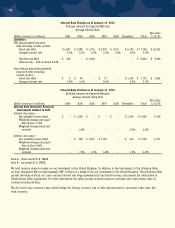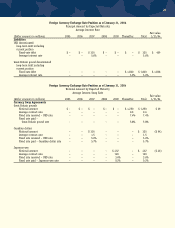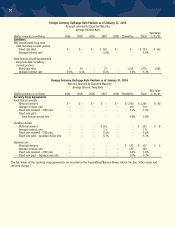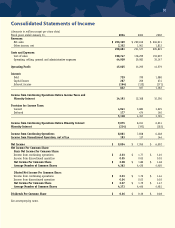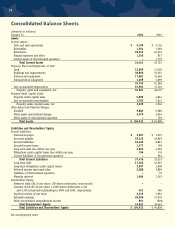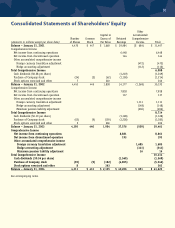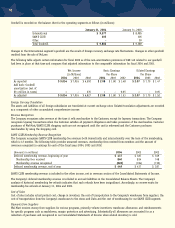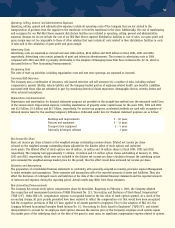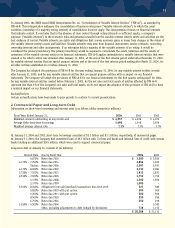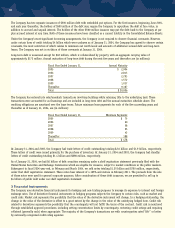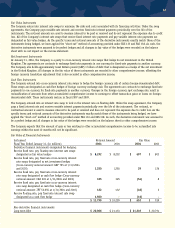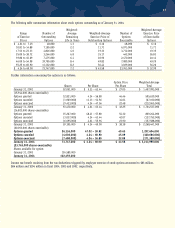Walmart 2004 Annual Report Download - page 40
Download and view the complete annual report
Please find page 40 of the 2004 Walmart annual report below. You can navigate through the pages in the report by either clicking on the pages listed below, or by using the keyword search tool below to find specific information within the annual report.
38
Goodwill is recorded on the balance sheet in the operating segments as follows (in millions):
January 31, 2004 January 31, 2003
International $ 9,577 $ 8,985
SAM’S CLUB 305 305
Other -99
Total Goodwill $ 9,882 $ 9,389
Changes in the International segment’s goodwill are the result of foreign currency exchange rate fluctuations. Changes in other goodwill
resulted from the sale of McLane.
The following table adjusts certain information for fiscal 2002 as if the non-amortization provisions of FAS 142 related to our goodwill
had been in place at that time and compares that adjusted information to the comparable information for fiscal 2004 and 2003.
Net Income Basic Earnings Diluted Earnings
(in Millions) Per Share Per Share
2004 2003 2002 2004 2003 2002 2004 2003 2002
As reported $ 9,054 $ 7,955 $ 6,592 $ 2.08 $ 1.80 $ 1.48 $ 2.07 $ 1.79 $ 1.47
Add back: Goodwill
amortization (net of
$11 million in taxes) – – 235 – – 0.05 ––0.05
As adjusted $ 9,054 $ 7,955 $ 6,827 $ 2.08 $ 1.80 $ 1.53 $ 2.07 $ 1.79 $ 1.52
Foreign Currency Translation
The assets and liabilities of all foreign subsidiaries are translated at current exchange rates. Related translation adjustments are recorded
as a component of other accumulated comprehensive income.
Revenue Recognition
The Company recognizes sales revenue at the time it sells merchandise to the Customer, except for layaway transactions. The Company
recognizes layaway transactions when the Customer satisfies all payment obligations and takes possession of the merchandise. Customer
purchases of Wal-Mart/SAM’S CLUB shopping cards are not recognized until the card is redeemed and the Customer purchases
merchandise by using the shopping card.
SAM’S CLUB Membership Revenue Recognition
The Company recognizes SAM’S CLUB membership fee revenues both domestically and internationally over the term of the membership,
which is 12 months. The following table provides unearned revenues, membership fees received from members and the amount of
revenues recognized in earnings for each of the fiscal years 2004, 2003 and 2002:
(Amounts in millions) 2004 2003 2002
Deferred membership revenue, beginning of year $ 437 $ 387 $ 369
Membership fees received 840 834 748
Membership revenue recognized (828) (784) (730)
Deferred membership revenue, end of year $ 449 $ 437 $ 387
SAM’S CLUB membership revenue is included in the other income, net in revenues section of the Consolidated Statements of Income.
The Company’s deferred membership revenue is included in accrued liabilities in the Consolidated Balance Sheets. The Company’s
analysis of historical membership fee refunds indicates that such refunds have been insignificant. Accordingly, no reserve exists for
membership fee refunds at January 31, 2004 and 2003.
Cost of Sales
Cost of sales includes actual product cost, change in inventory, the cost of transportation to the Company’s warehouses from suppliers, the
cost of transportation from the Company’s warehouses to the stores and Clubs and the cost of warehousing for our SAM’S CLUB segment.
Payments from Suppliers
Wal-Mart receives money from suppliers for various programs, primarily volume incentives; warehouse allowances; and reimbursements
for specific programs such as markdowns, margin protection and advertising. Substantially all allowances are accounted for as a
reduction of purchases and recognized in our Consolidated Statements of Income when related inventory is sold.


